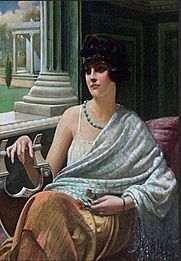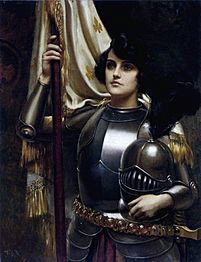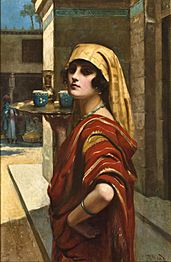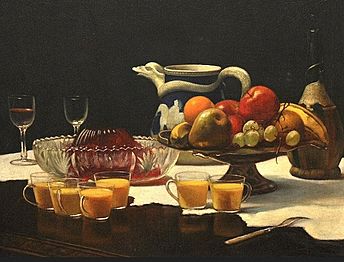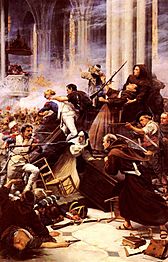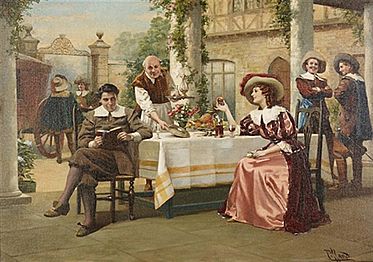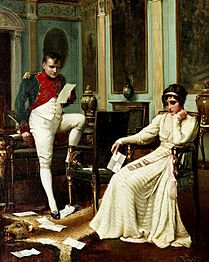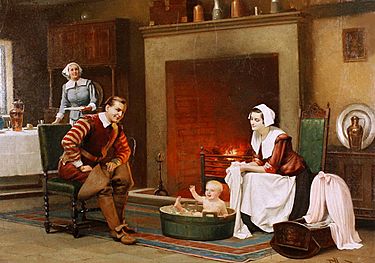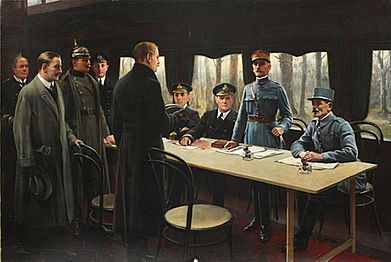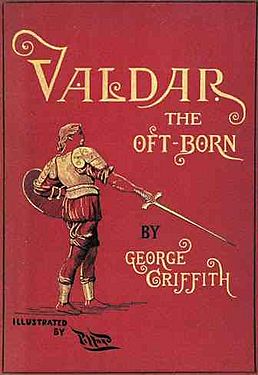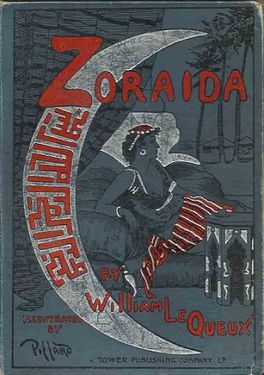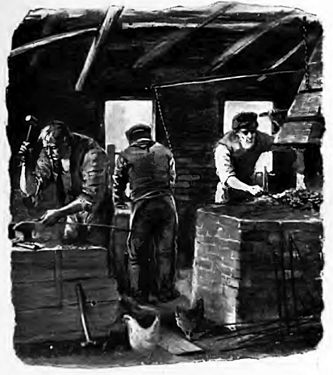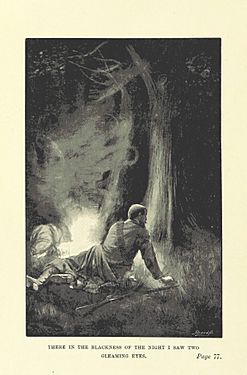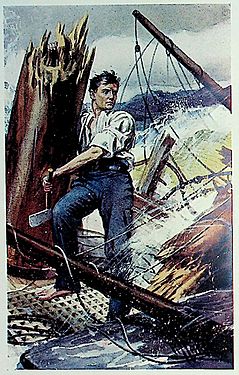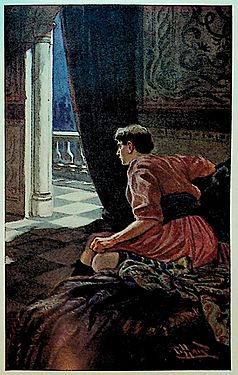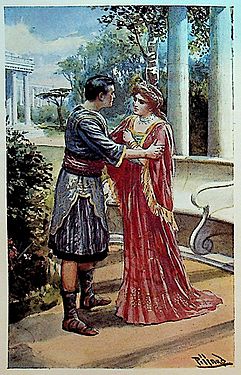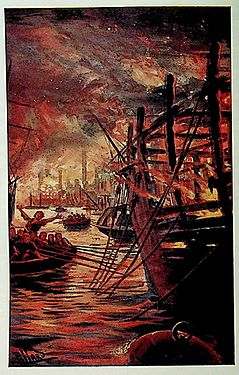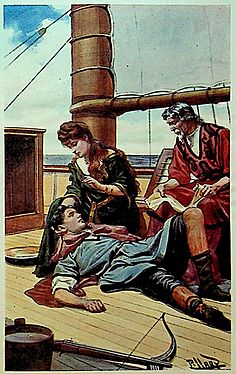Harold H. Piffard facts for kids
Quick facts for kids
Harold H. Piffard
|
|
|---|---|
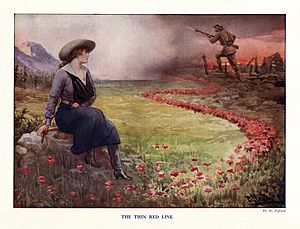
The Thin Red Line by Harold H. Piffard
|
|
| Born | 10 August 1867 33 Blandford Square, Marylebone, London
|
| Died | 17 January 1938 (aged 70) |
| Resting place | Old Chiswick Cemetery |
| Nationality | British |
| Known for | Artist, aviator and illustrator |
| Movement | Orientalism |
| Spouse(s) |
Helena Katherine Docetti Walker
(m. 1895; died 1900)Eleanor Margaret Hoile
(m. 1902) |
Harold Hume Piffard (born August 10, 1867 – died January 17, 1938) was a talented British artist and illustrator. He was also one of the very first people in Britain to fly an airplane!
Contents
Harold Piffard's Early Life
Harold Hume Piffard was born in Marylebone, London. His parents were Charles and Emily Piffard. Charles was a lawyer who worked in Calcutta, India. Harold was the sixth son in his family. His four older brothers were all born in India.
Harold went to Lancing College, a school in England, with his older brother Lawrence in 1877. When he was about 13, he ran away from school! He wanted to become an actor. He even slept on the Embankment for a few nights while looking for work in theaters.
In 1884, Harold traveled to India. He spent some time exploring the country. He also worked on a tea plantation there.
Becoming an Artist
Harold returned to London in 1889. He began to study art at the Royal Academy Schools. This is a famous art school. In 1895, he showed his first painting at the Royal Academy.
A month later, on June 4, 1895, Harold married Helena Katherine Docetti Walker. She was the daughter of a jute manufacturer. Harold and Helena lived in Chiswick, London, for many years.
Harold and Helena had four children:
- Harold Reginald Grahame Sherard Piffard (born 1896 – died 1917): He moved to New Zealand. He later joined the army and was sadly killed in France during World War I.
- Dorothy Helena Hume Piffard (born 1898 – died 1969): She also became an artist, just like her father.
- Ivan Adrian Augustus Piffard (born 1899 – died 1993)
- Grahame Laurence Piffard (born 1900 – died 1901): He passed away when he was only three months old.
Helena died in 1900, soon after her fourth child was born. Harold married again in 1902. His second wife was Eleanor Margaret Hoile. She was also the daughter of a jute merchant. Harold and Eleanor had one son:
- Hume Piffard (born 1905 – died 1976): He trained to be an engineer.
Harold Piffard passed away on January 17, 1938. He is buried in Old Chiswick Cemetery, along with his first wife, Helena.
Harold Piffard the Aviator
First Flights in Acton
Harold Piffard was not just an artist; he was also fascinated by flying! In 1907, he started building model airplanes. He even won a prize for one of his models in 1909.
Later in 1909, he began to build a real airplane. He used an 8-cylinder engine. He built the plane's body in his art studio. He rented a shed near his home to put the aircraft together. It was a biplane, meaning it had two main wings.
He tested his plane on a field in Ealing. He managed to get the plane off the ground! It flew "a foot or two from the ground for a distance of a hundred yards or so." Sadly, on December 3, 1909, a big storm destroyed his aircraft and its shelter.
Flying at Shoreham
After the storm, Piffard helped start a company called the Aviator's Finance Company. They rented land at Shoreham-by-Sea that already had a hangar for planes.
With help from others, they redesigned the aircraft. On May 3, 1910, their new plane, named Hummingbird, was ready. It could take off in short jumps, which earned it the nickname "The Grasshopper." The field had hidden ditches, so the plane often crashed.
In September 1910, he flew the Hummingbird at a height of 30 or 40 feet for half a mile. He flew across the field to a nearby hotel in about 40 seconds! He hadn't learned how to turn the plane in the air yet. So, the plane had to be wheeled back to the hangar. But he still celebrated his flight!
A film company wanted to record one of his flights. Piffard agreed. He ignored warnings about a dangerous ditch and tried to fly over it. The plane crashed completely, and it was all caught on film! The cameraman noticed that Piffard didn't seem upset. He even looked a bit satisfied.
In 1911, Piffard tried out a new aircraft called the Piffard Hydroplane. This plane had floats and wheels, so it could land on water. He tested it on Shoreham beach, but it wasn't successful. After this, he stopped building and flying airplanes. He went back to working as an artist and illustrator. The land at Shoreham later became Shoreham Airport.
Harold Piffard the Artist
Painter
Harold Piffard painted many different things. He used both oil paints and watercolors. His paintings included classical scenes, historical events, and everyday life.
Illustrator
Piffard also worked as an illustrator. This means he drew pictures for books and magazines. He drew for popular magazines like The Strand Magazine and The Illustrated London News.
Starting in 1895, he illustrated over a hundred novels! He worked with many famous authors. These included Frances Hodgson Burnett, who wrote The Secret Garden, and Charles Dickens, who wrote Oliver Twist. He also illustrated classic books for Collins publishers.
-
Interior of a Bromsgrove Nailmaker's shed, 1896
Illustrations for a Children's Book
Here are six illustrations Piffard made for a book called Geoffrey Harrington's Adventures. This book was written by Harry Collingwood and published in 1907.
Harold Piffard's Legacy
In 2007, the Shoreham Airport Historical Association built a copy of Piffard's Hummingbird airplane. This shows how important his early flying efforts were!
Images for kids
See also
 In Spanish: Harold H. Piffard para niños
In Spanish: Harold H. Piffard para niños


